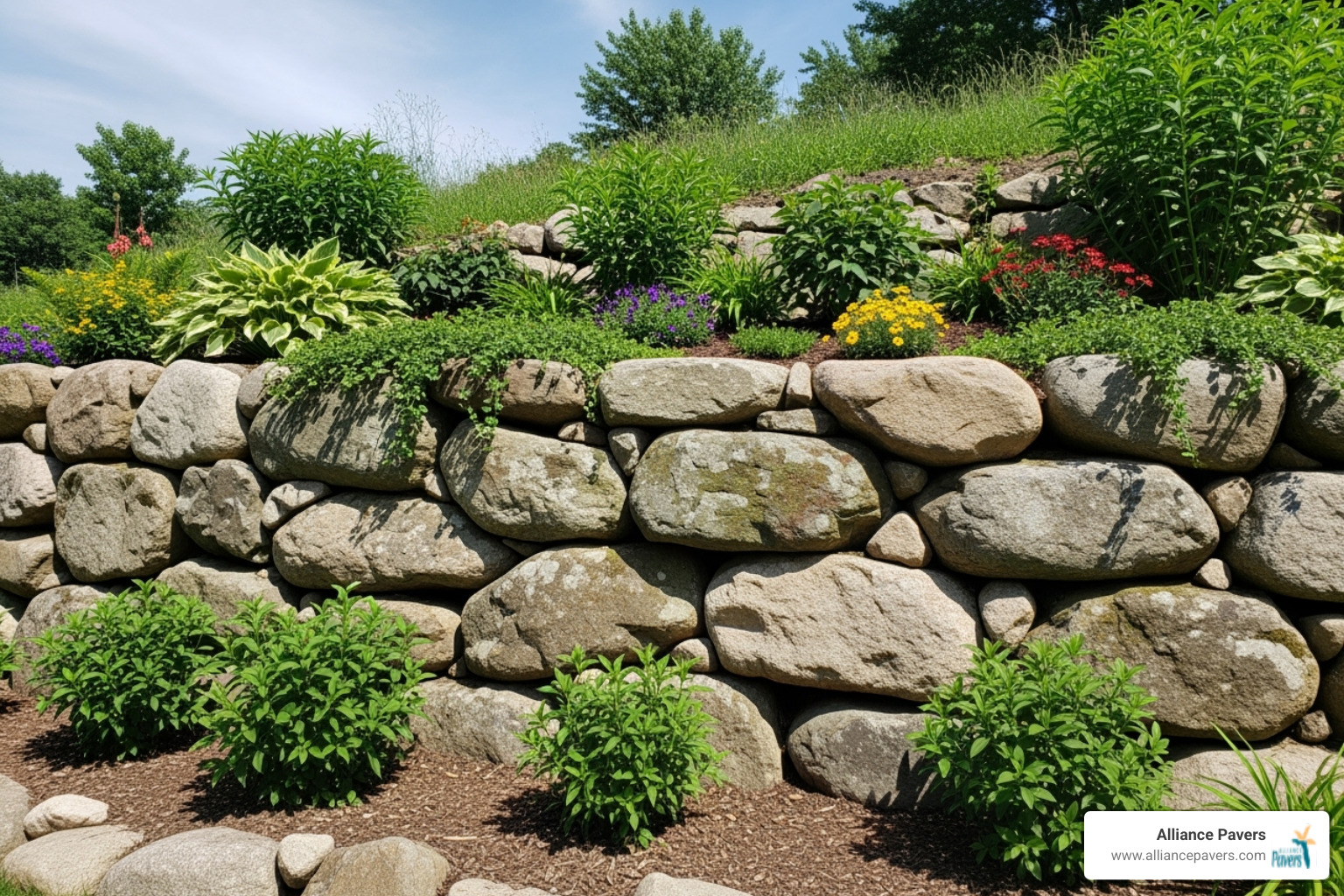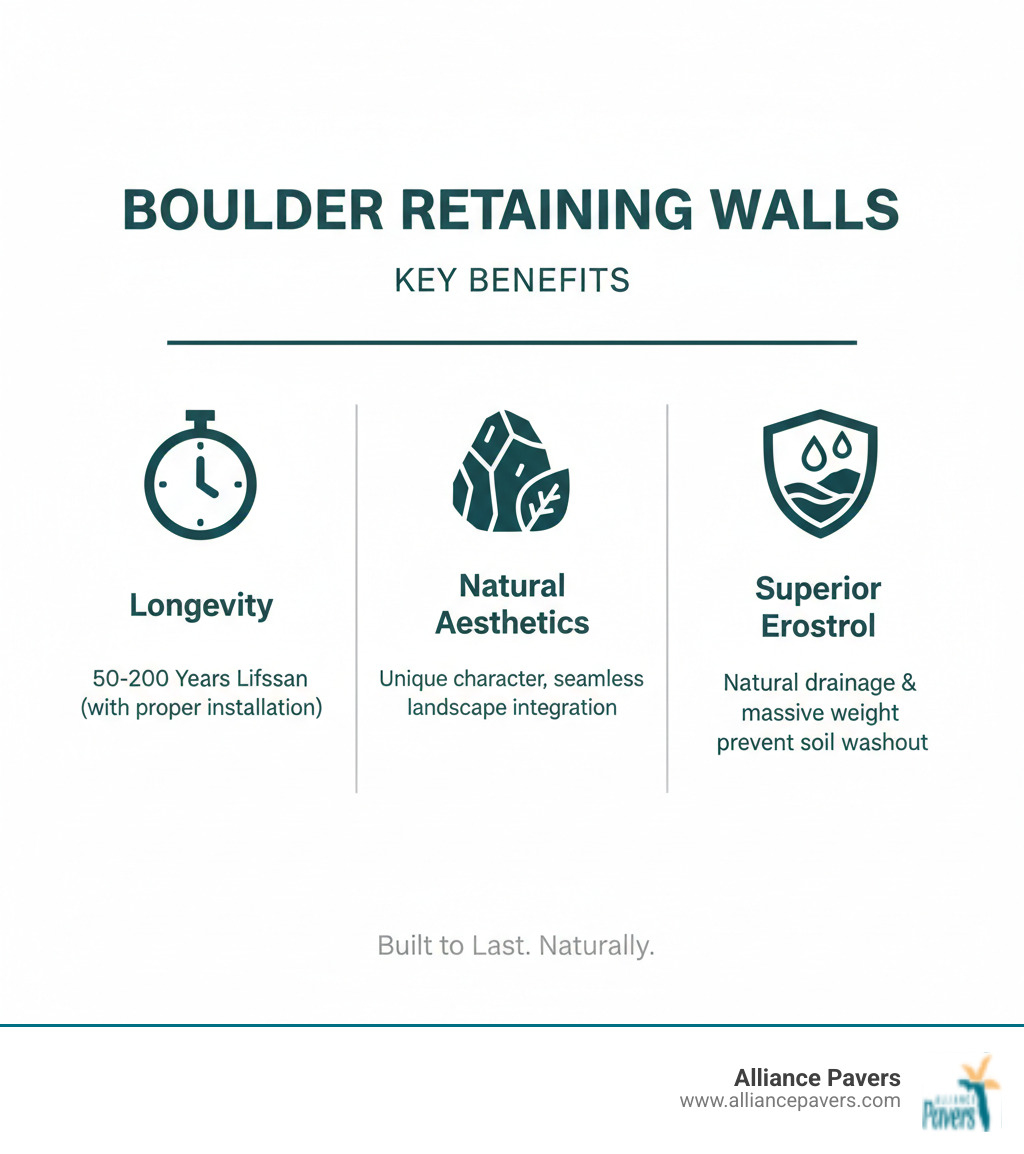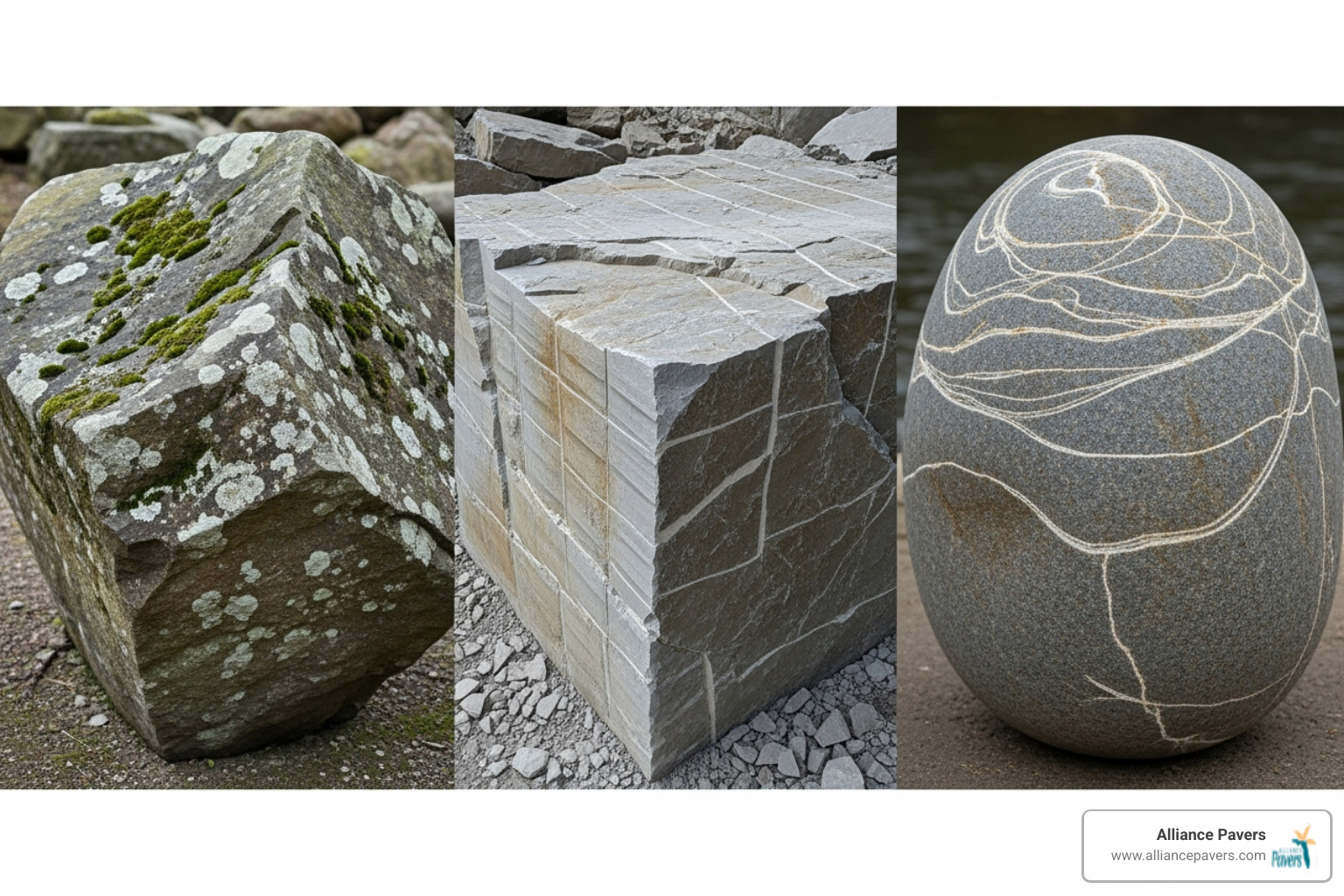
Why Large Boulders Create Superior Retaining Walls
Large boulders for retaining walls offer the best natural strength and timeless beauty for any landscape project. These massive stones create structures that can last 50 to 200 years while seamlessly blending into your outdoor environment.
Key Benefits of Large Boulder Retaining Walls:
- Exceptional Durability - Natural stone resists weather, erosion, and degradation.
- Natural Drainage - Irregular shapes create gaps that relieve water pressure.
- Unique Aesthetics - Each boulder is different, creating one-of-a-kind walls.
- Environmental Benefits - No manufacturing is required, and they create wildlife habitats.
- Long-term Value - Minimal maintenance with decades of reliable performance.
Boulder retaining walls use sheer mass and strategic placement to hold back soil. Unlike manufactured blocks, these natural stones offer built-in drainage through the gaps between them, which helps prevent the water pressure buildup that destroys many retaining walls.
The key to a long-lasting wall lies in proper foundation preparation, correct boulder placement with a slight backward lean, and a comprehensive drainage system. These walls excel at stabilizing slopes, preventing erosion, and enhancing landscape aesthetics with far less maintenance than other materials. The natural variations in size, shape, and color give your wall a character that manufactured products cannot match.

The Best Benefits of a Boulder Retaining Wall
Large boulders for retaining walls bring together the strength you need with the natural beauty that makes your property feel like home.
Natural Aesthetics
Every boulder has its own story, shape, and color. When you choose large boulders for retaining walls, you're adding a piece of natural art to your landscape. Unlike uniform manufactured blocks, each boulder has its own personality, from rounded and smooth to angular and dramatic.
This unique character means your wall will be one-of-a-kind. The irregular shapes and natural variations create visual interest that manufactured products can't replicate. A properly designed boulder wall doesn't fight against your landscape—it improves it, looking like a natural rock outcropping. For inspiration, see this collection of Retainer Wall, Boulders-Outcroppings on Pinterest.
Durability & Longevity
A well-built boulder retaining wall can last 50 to 200 years. This incredible lifespan comes from the fundamental strength of natural stone, which has already survived thousands of years of nature's toughest tests.
Weather resistance is where boulders truly shine. They are not significantly affected by freeze-thaw cycles, summer heat, or heavy rains. Even in Florida's challenging climate, boulder walls stand strong year after year. This durability translates into peace of mind and adds permanent value to your property.
Erosion Control
Large boulders for retaining walls are nature's own solution to soil erosion. Their massive weight and strategic placement act as anchors, holding tons of soil in place. Unlike a solid concrete wall, boulder walls work with water instead of fighting it. The natural gaps between stones allow water to flow through, preventing dangerous hydrostatic pressure from building up behind the wall.
This natural drainage system is crucial for managing water runoff while keeping the soil stable, even during Florida's most challenging weather.
Environmental Benefits
Choosing boulder walls is an environmentally friendly choice. Since you're using natural materials that don't require energy-intensive manufacturing, you're reducing your project's carbon footprint.
The benefits go deeper, as boulder walls excel at creating microhabitats. The crevices between stones become homes for beneficial insects, small lizards, and native plants. These mini-ecosystems contribute to your property's biodiversity, as your wall becomes a living part of your landscape's ecosystem.
Key Considerations for Your Boulder Wall Project
Planning a project with large boulders for retaining walls requires thoughtful preparation. At Alliance Pavers, our 25 years of experience have taught us that lasting walls begin with a solid plan.

Site Assessment
Understanding your property is the first step. A thorough site assessment includes:
- Soil type analysis: Determines the foundation needs. Sandy soils drain well but may need landscape fabric, while clay soils hold water and require robust drainage solutions.
- Drainage patterns: Shows where water naturally flows, allowing us to design a system that guides it safely away from the wall.
- Slope grade: Dictates the engineering required. Steeper slopes demand a more robust structure to handle the increased pressure.
- Access for machinery: Large boulders for retaining walls are heavy. We need to ensure our excavators and other equipment can access the site safely and efficiently.
Local Permits & Regulations
To ensure your project is legal and safe, we handle all local rules from the start. Wall height restrictions often require permits and professional engineering for walls over 4 feet. Engineering requirements are also common for walls supporting heavy loads (like driveways) or built on challenging soil. Understanding these rules upfront saves time and money. Our Hardscaping experience includes managing these regulatory details.
Choosing the Right Types of large boulders for retaining walls
Selecting the right boulder affects both appearance and construction.
- Fieldstone: Offers a weathered, rustic look. Their irregular shapes require more skill to stack for stability.
- Quarry boulders: Have more angular, consistent shapes, making them easier to fit together for a structured appearance.
- River-washed boulders: Polished smooth by water, they have a beautiful organic look but can be challenging to stack securely due to their rounded shapes.
Each type has its place. Fieldstone is great for natural settings, quarry boulders are ideal for structured walls, and river-washed stones create stunning focal points.
Calculating Your Material Needs
Getting the material calculation right is crucial. The process involves:
- Estimating tonnage: Based on the wall's length, height, and depth, we calculate the volume needed, accounting for the natural gaps between boulders.
- Base material calculation: We determine the volume of compacted gravel needed for the foundation trench.
- Backfill material: This includes the clean drainage gravel that goes behind the wall (usually a 12-inch layer) to prevent water damage.
We always order slightly more material than calculated to ensure we have the best selection of stones for a perfect fit and to avoid construction delays.
A Guide to Building with large boulders for retaining walls
Building a boulder retaining wall is where construction meets artistry, requiring expertise, precision, and the right equipment.

Foundation Preparation
A great wall starts with a perfect foundation. The process involves excavating a trench that is wider and deeper than the first row of boulders to anchor the wall. We then add and compact a 4- to 6-inch compacted gravel base to create a level, stable platform. In areas with unstable soil, we lay down landscape fabric to prevent materials from mixing over time.
Boulder Placement Technique
Placing multi-ton stones is a job for experts. We use heavy equipment like excavators with grapple attachments to position each boulder with precision. The key is creating an interlocking pattern, where each boulder rests on at least two below it, distributing weight evenly. We start with the largest, flattest boulders at the base. A slight backward lean, or batter (about 1 inch per vertical foot), is built in to help the wall resist soil pressure. You can see examples of this precision work in our Windermere projects.
Essential Drainage Solutions
Proper water management is critical to a wall's longevity. While the gaps in large boulders for retaining walls help, a full drainage system is essential for preventing hydrostatic pressure. We install a perforated drainage pipe at the base behind the wall, surrounded by at least 12 inches of clean drainage gravel. This system is often wrapped in filter fabric to prevent clogging. The natural gaps between stones act as weep holes, allowing water to escape.
Safety Precautions During Construction
Safety is non-negotiable when working with massive boulders.
- Professional expertise is essential for safe handling and operation.
- Heavy machinery operation requires trained operators and clear safety zones.
- Personal Protective Equipment (PPE), including hard hats and steel-toed boots, is mandatory.
- Securing the work area keeps unauthorized people, children, and pets safe.
- We always follow the cardinal rule: never stand under suspended loads.
Boulder Walls vs. Engineered Blocks: Which is Right for You?
When you're planning a retaining wall for your property, you'll find yourself choosing between two main approaches: the natural beauty of large boulders for retaining walls and the precision of engineered blocks (also called segmental retaining walls). The right choice depends on your specific needs, aesthetic preferences, and site conditions.
| Feature | Boulder Retaining Walls | Segmental Retaining Walls |
|---|---|---|
| Aesthetics | Natural, rustic, unique; each stone is different; blends seamlessly with natural landscapes. | Uniform, modern, clean lines; wide range of colors and textures; can mimic natural stone but with repetition. |
| Installation | Requires heavy machinery and skilled operators for precise placement; slower due to irregular shapes; more artistic. | Can be installed manually for smaller blocks or with machinery for larger units; faster for uniform blocks; relies on interlocking systems. |
| Durability | Exceptional longevity (50-200+ years); natural stone resists weather and degradation; minimal maintenance. | Very durable; engineered for specific loads; often requires geogrid reinforcement for taller walls; lifespan typically 50-100 years. |
| Flexibility | Excellent for natural curves and informal designs; good for creating microclimates for plants. | Highly versatile for straight walls, curves, and corners; can be engineered for significant heights and loads; often requires geogrid for structural integrity. |
Performance Comparison
Boulder walls and engineered blocks handle forces differently. Large boulders for retaining walls have natural drainage gaps that relieve water pressure, though a full drainage system is still required. Segmental walls have a solid face and rely entirely on an engineered drainage system behind the wall.
For stability, boulder walls use weight and mass. Their sheer gravitational force holds back soil. Engineered blocks are lighter and use interlocking systems, often with geogrid reinforcement that turns the soil itself into part of the structure.
Aesthetic Differences
Your personal taste is the deciding factor here. Boulder walls offer a natural and rustic charm, making them look as if they've been there for centuries. They are perfect for naturalistic landscapes. Engineered blocks provide a uniform and modern aesthetic with clean lines and consistent patterns, which works well in contemporary or formal settings. For more on engineered systems, learn about Segmental Retaining Walls.
DIY vs. Hiring a Professional
For large boulders for retaining walls, this is a question of safety and expertise. The safety risks are significant, as the stones can weigh several tons and require heavy equipment operated by trained professionals.
For walls over 4 feet, professional engineering is typically required by law. Most importantly, ensuring longevity means getting every detail right, from the foundation to the drainage. A DIY mistake can lead to a failed wall. Given the risks and complexity, hiring a professional is the wisest choice. We can help you make the right decision for your property, whether you need to Find retaining wall contractors in Lake Nona or elsewhere in Central Florida.
Frequently Asked Questions about Boulder Retaining Walls
When homeowners consider investing in large boulders for retaining walls, they naturally have questions. After 25 years of building these impressive structures across Central Florida, we've heard just about every concern and curiosity. Let's address the questions that come up most often.
How long can a properly built boulder retaining wall last?
A well-built boulder wall has exceptional longevity, lasting from 50 to 200 years, sometimes longer. The lifespan depends on several factors: installation quality, the stone type used, the effectiveness of the drainage system, and proper maintenance. We build walls designed to last for generations.
What are the best practices for maintaining a boulder wall?
Boulder walls are remarkably low-maintenance. Key practices include:
- Regular inspections: Walk around the wall periodically, especially after storms, to check for any changes.
- Checking for shifting or erosion: Look for any movement in the boulders or soil washing out from behind the wall. Address small issues before they become big problems.
- Managing vegetation growth: Prevent large trees or shrubs with aggressive roots from growing too close to the wall.
- Ensuring drainage paths are clear: Keep weep holes and pipe outlets free of debris to allow water to escape freely.
Are boulder walls suitable for all types of soil?
Yes, boulder walls are versatile enough for all soil types, but the design must be adapted to the specific conditions. The importance of a solid foundation cannot be overstated, regardless of the soil. Unstable soils may require engineering to ensure long-term stability. For example, clay soils require robust drainage to handle water retention, while sandy soils may need landscape fabric to prevent washout. We adapt our construction methods to suit every soil type in Central Florida.
Conclusion: Bring Natural Strength to Your Landscape
When you choose large boulders for retaining walls, you are investing in a solution that combines durability, timeless beauty, and functional strength. These walls can last for over a century, blend seamlessly into the landscape, and provide superior erosion control with minimal maintenance.
The key to a successful boulder wall lies in professional execution—from site assessment and foundation prep to expert boulder placement and drainage. This is not a simple DIY project; it requires experience and the right equipment to ensure a safe and lasting result.
At Alliance Pavers, we have spent 25 years perfecting the art and science of building with large boulders for retaining walls. As a family-owned company in St. Cloud, FL, we understand Central Florida's unique landscape challenges. Our team delivers walls that are not just functional, but truly beautiful.
Ready to transform your property with the natural strength and enduring beauty of stone? We'd love to help you Transform your property with a stone retaining wall that will be a source of pride for years to come.
Recent Posts
Windermere Poolside Pavers: Where Elegance Meets the Water
Top Your Wall with Style: Understanding Paver Stone Caps
Customer Testimonials
Hear what our satisfied customers have to say about the quality, reliability, and personal touch that set us apart.
Ready to Transform Your Home?





